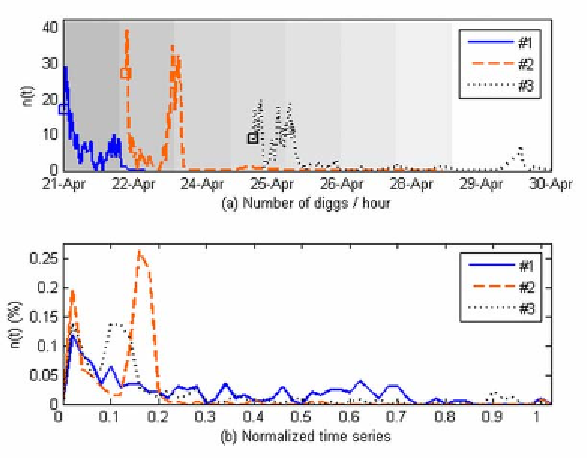Database Reference
In-Depth Information
where
min(T)
,
max(T)
return the minimum
and maximum timestamp values of the input
timestamp set. In that way, it is possible to nor-
malize the temporal activity of an SBS entity to
an artificial temporal space spanning the interval
[0, 1], which makes it possible to perform a set
of operations between time series, e.g. addition,
subtraction, averaging and so on. This possibility
is of significance since we are particularly inter-
ested in deriving an “average” time series which
is representative of hundreds or even thousands
of time series. Figure 2 depicts the effect of the
transformation on the set of time series of Figure
1 (under the representation
n(t)
, i.e. number of
events per time interval). One should note that
while the transformation removes the notion of
temporal scale from the individual time series, it
preserves their structural characteristics.
Finally, it is possible to apply the transforma-
tion of Equation 3 to a subsequence of a given
time series and in that way to map a particular
“phase” of a time series to the
[0, 1]
interval
with the purpose of comparing the evolution of
the phenomenon within this phase to its evolu-
tion within the full lifetime of the time series.
Comparison between time series phases provides
additional insights to the understanding of tempo-
ral phenomena, especially in cases where there is
prior knowledge that a phenomenon takes place
in more than one phases.
Semantic Aspects of
content Popularity
In a social media website where a stream of online
stories is continuously flowing through the site's
pages, one could argue that the popularity (number
of votes) of a given resource (e.g. news article)
will strongly correlate with the semantic content
featured by the story as well as the linguistic
style of the story text. Stories usually appear in
the form of a short title and description which
should provide sufficient incentive to readers to
read the whole story and then vote in favor of it.
Therefore, one could attempt to predict which
stories will draw the attention of the masses by
Figure 2. The effect of the proposed time series normalization

Search WWH ::

Custom Search